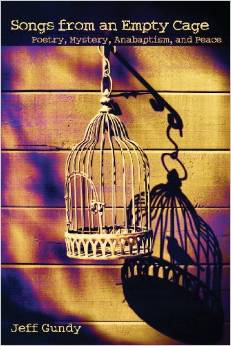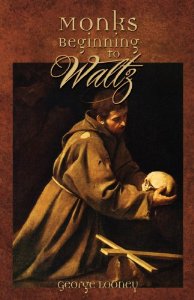Jeff Gundy. Songs from an Empty Cage: Poetry, Mystery, Anabaptism, and Peace. Cascadia Publishing House, 2013. 294 pages. $23.95
Reviewed by Lynn Domina
I am not the ideal audience for Jeff Gundy’s Songs from an Empty Cage: Poetry, Mystery, Anabaptism, and Peace, though I think I come close. I am a poet, after all, with a particular interest in the links between spirituality and creativity, and one who finds the transcendent and immanent equally compelling. But I am not a member of an Anabaptist tradition despite my attraction to some of the impulses behind the historic peace churches. So reading this book as someone who is a near bystander but not a member of Gundy’s community was a provocative and satisfying yet also odd experience. I noticed my readerly identity more than I often do while reading, and I recognized my outsider status, but I was an outsider this time because I am not in the minority, as Amish, Mennonites, and members of the Church of the Brethren almost always are—that was the odd part.
Songs from an Empty Cage consists of sixteen essays that engage the intersections of the four terms in the book’s subtitle. One of Gundy’s goals is to participate in a style of divine exploration that has recently come to be known as theopoetics. Theopoetics isn’t just eloquently written theology or poetry that functions as theology, but a different approach, a more imaginative stance, within theology. It is a theology of the mystics. It aims to infuse theology—which often strives for finitude and certainty and closure—with a poet’s approach to the world, an appreciation of mystery and longing and openness. Theopoetics, in other words, might be less concerned with doctrine as a source of truth than with metaphor and image as a means of exploring possibility.
Some of these essays are directed specifically toward Anabaptists, especially Mennonites, and assume some familiarity with Anabaptist history (the significance of the Martyr’s Mirror, radical violence in 16th century Münster) and contemporary political and theological questions (in the work of theologian John Howard Yoder for example). These essays both puzzled and intrigued me. Gundy provides enough context for those of us outside his tradition to situate ourselves, but he doesn’t feel compelled to rehearse the entire history of the Protestant Reformation or of Anabaptism’s place within it. As a result, I could follow his arguments, but I also felt a newly kindled curiosity, a desire to learn more.
Many of the essays are structured as interesting hybrids of memoir, intellectual argument, and creative expression. They enact, therefore, Gundy’s attraction to heresy (he confesses, on the first page of his introduction, to a “fascination (mostly intellectual) with transgression, opposition, and ‘heresy’”) by refusing rigid generic boundaries—without drawing unnecessary overt attention to the fact that that is what he’s doing. I don’t mean simply that he includes some poetry within his prose, but more importantly that he crosses the major division that existed in many English departments during the latter part of the twentieth century—that between the creative writers and the analytical writers, the emotive types and the intellectuals—a division that more recently seems to be dwindling, for which I am exceedingly grateful. Because of the structure of these essays, we not only witness a mind thinking, but we’re also privy to some of the intuitive leaps that mind makes.
“’Truth Did Not Come into the World Naked’: Images, Stories, and Intimations,” for example, illustrates Gundy’s struggle with abstraction. It begins with an anecdote—he had been invited to reflect on the contributions of a colleague, J. Denny Weaver, and to address among other topics how his “viewpoint on Christology” related to Weaver’s work. Rather than explain his understanding of Christ directly, comparing or contrasting it with Weaver’s, Gundy recalls a poem, “How the Boy Jesus Resisted Taking Out the Trash.” He includes the poem in this section of his essay, and then goes on to consider how his poem corresponds to the nature or style of some of Jesus’ teaching. Gundy’s response is decidedly elliptical, but then Jesus was also at times an elliptical fellow. In considering theological questions, Gundy returns again and again to the concrete and incarnate. He includes several other brief narratives in this essay, referencing Walt Whitman, Thomas Merton, the apocryphal Gospel of Philip, James Wright, and others with equal ease. The essay concludes with a description of a “poetry night hike,” organized by Gundy, that went awry. He blamed himself, but got a poem out of it anyway, “Where Water Finds an Edge,” which begins with the line “Nothing like a careful, thorough plan with one large error.” The speaker of the poem searches for a place to sit beside the river, and then the poem continues:
Every stone is a section of the mind of God, every leaning tree and breathing creature. We need the dark because it makes us clumsy,
because it makes us forget the banks we are rushing between, muttering about hymns and women while the Falls open before us. We will not need to be ready
to tumble down. We will shine and shout and all the damage will be forgotten soon. The water is not wounded by its breathless journey,
it bears its troubles lightly, it winks to the sun, it does not falter as the full night arrives. And the hard ledges glow, long after all else is lost.
The essay ends one paragraph later, with a reflection on the gift of error, the value of stumbling through the dark. Both the poem and the essay demonstrate the style, substance, and value of theopoetics. Rather than endlessly searching after certainty, we might become like the water, forgiving ourselves for our own clumsiness on our own “breathless journey,” leaping forward even “as the full night arrives.” Gundy never does directly address the instruction he began with, to provide some description or definition of his Christology. Nevertheless, by concluding the essay with this poem, he suggests that theology, too, needs its own darkness, its own glowing ledges. Precisely by living fully as incarnated beings in this world, he seems to say, we inhabit the mind of God.
Many of the essays in this collection reward close readings. Like the best theology and the best poetry, they open out onto the world.


